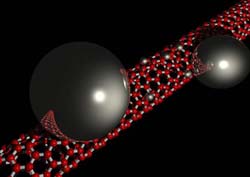Materials Sciences
Materials management deals with the research, development, manufacturing and processing of raw and industrial materials. Key aspects here are biological and medical issues, which play an increasingly important role in this field.
innovations-report offers in-depth articles related to the development and application of materials and the structure and properties of new materials.

New high-tech concrete is lighter, stronger & green
Australian scientists have developed a breakthrough low-cost, lightweight, concrete technology that is set to lower costs and speed up construction projects from residential homes to high-rise buildings.
HySSIL (High-Strength, Structural, Insulative, Lightweight) panels are manufactured using a new low energy, process developed by CSIRO Novel Materials & Processes. Dr Swee Liang Mak, who leads the HySSIL development team at CSIRO says, ’HySSIL is a revolutionary aerated cementitious (cement

Nano-scale trees created at Lund Institute of Technology
For the last few years scientists at the Nanometer Consortium at Lund University have been able to make nanowires, tiny wires just a few millionths of a millimeter “thick” and made of semiconducting material of great potential in the electronics industry. Now they have managed to produce “nanotrees,” in fact tiny forests on the same scale.
This is described in an article (“Synthesis of branched ‘nanotrees’ by controlled seeding of multiple branching events”) in the journal Nature Materials,

Laser technique used to build micro-polymeric structure on a human hair, without harming it
First demonstration that ’MAP’ laser technique can be used non-destructively on biomaterials; potential applications range from medical research to fiber optics
Researchers in the laboratory of Boston College Chemistry Professor John T. Fourkas have demonstrated the fabrication of microscopic polymeric structures on top of a human hair.
Fourkas, in collaboration with Boston College Physics Professor Michael J. Naughton and Professors Malvin C. Teich and Bahaa E. A.

A Conveyor Belt for the Nano-Age
In a development that brings the promise of mass production to nanoscale devices, Lawrence Berkeley National Laboratory scientists have transformed carbon nanotubes into conveyor belts capable of ferrying atom-sized particles to microscopic worksites.
By applying a small electrical current to a carbon nanotube, they moved indium particles along the tube like auto parts on an assembly line. Their research, described in the April 29 issue of Nature, lays the groundwork for the high-throughput

NJIT grad student and professor take ride of their lives in vomit comet
Actually, doctoral candidate Alexandre Ermoline, North Arlington, NJ and NJIT Assistant Research Professor Mirko Schoenitz , PhD, Princeton, NJ, took four rides over four days aboard a KC-135 aircraft operated by the National Aeronautics and Space Administration (NASA). NASA operates the craft at the Lyndon B. Johnson Space Center in Houston which advances research in microgravity.
“Moving without gravity is an unusual sensation,” recently recalled Schoenitz. “I’ve heard people describ

Nanogold does not glitter, but its future looks bright
At the nano-level, gold acquires a new shine, a new set of properties and a host of potential new applications
All that glitters is not gold, goes the old adage.
But the shrinking frontiers of science require a qualifier: Gold itself does not always glitter.
In fact, if gold is created in small enough chunks, it turns red, blue, yellow and other colors, says Chris Kiely, who directs the new Nanocharacterization Laboratory in Lehigh’s Center for Advanced Materi